Charming Nation an exhibition of paintings by NS Harsha
till Nov 29 at Max Mueller Bhavan
Exhibition of recent paintings by Unnikrishnan
till Nov 29 at Chitrakala Parishath
Exhibition of recent paintings by Paresh Hazra
Nov 29 to Dec 1 at Welcom Art Gallery
Dec 2 to 8 at Rightlines Art Gallery
28 Nov 2006
27 Nov 2006
Review - Shankar Kendale
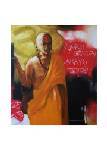
Art director to painter. Shankar Kendale gave up a successful career in the advertising world to become a full time artist. The transition happened about ten years ago, when he took a year-long break to explore his painterly skills. His works are mostly figurative, although he has done a few abstracts in the past. The current series features portraits of men and women amidst rural settings. Kendale places his subjects against rustic settings, adds pots and other rural bits and pieces to create a pretty picture. He is technically sound and has a good sense of light and shade. The backgrounds in general are fairly abstracted apart from a door or a step against which he props his subject. Traces of his design background are evident in all his works – in the composition and choice of colors. Overall, pleasant works and reasonably priced.
Prices range between Rs 25,000 and Rs 70,000.
The exhibition is on till Nov 30 at KYNKYNY.
23 Nov 2006
Art Buzz
There is a lot more happening in the art world this winter in Bangalore...
Recent paintings by Jyoti & Shantkumar Hattarki
Nov 24 to Dec 9, 2006 at Crimson art gallery at Hatworks Boulevard
Paintings by Reba Hore
Nov 27 to Dec 7, 2006 at Gallery Sumukha
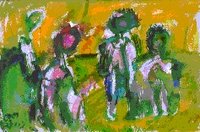
Abstract Notions - photographs by Shibu Arakkal
Nov 25 to Dec 5, 2006 at Galerie Sara Arakkal
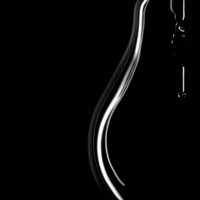
Gallery Sumukha opened in Chennai on November 15 with a group show entitled “Take Two”. The gallery was inaugurated by Jogen Chowdhury, with Laxma Goud as Guest of Honour. The exhibition features 78 works combined in unexpected cross-generational groupings and thematic ensembles. The striking variety of works - paintings, sculptures, etchings - together propose a series of conversations among the works and accentuate important innovations in Indian Contemporary Art. The exhibition signifies Sumukha's efforts in removing regional borders in Indian Contemporary Art by showcasing pan-Indian artists.
More events you know of... mail me...
Recent paintings by Jyoti & Shantkumar Hattarki
Nov 24 to Dec 9, 2006 at Crimson art gallery at Hatworks Boulevard
Paintings by Reba Hore
Nov 27 to Dec 7, 2006 at Gallery Sumukha

Abstract Notions - photographs by Shibu Arakkal
Nov 25 to Dec 5, 2006 at Galerie Sara Arakkal

Gallery Sumukha opened in Chennai on November 15 with a group show entitled “Take Two”. The gallery was inaugurated by Jogen Chowdhury, with Laxma Goud as Guest of Honour. The exhibition features 78 works combined in unexpected cross-generational groupings and thematic ensembles. The striking variety of works - paintings, sculptures, etchings - together propose a series of conversations among the works and accentuate important innovations in Indian Contemporary Art. The exhibition signifies Sumukha's efforts in removing regional borders in Indian Contemporary Art by showcasing pan-Indian artists.
More events you know of... mail me...
18 Nov 2006
Contemporary Indian Art – what about quality?
Gone are the days when artists had complete freedom to express their creativity in various ways. With greater creative freedom came more experiments and newer art trends. Whereas now due to the phenomenal growth in art prices, commercialization of art has taken a turn where more and more galleries are dictating terms to artists. Not only are artists ‘under contract’ by art galleries, but galleries have begun telling them what to work on. Based on the current demand, galleries ensure that the artist delivers, even if it means repeating series with a few minor changes. This is not based on general global trends but specific to the market demand of that particular artist. Shankar Kendale, a Bangalore based artist says, “The demand for my figurative works is much more than my abstracts and most galleries insist that I keep giving them figurative works. I have not been able to work on abstracts for the last two years.” On the plus side this translates into more sales. Despite the regular source of income some artists feel in five to ten years they run the risk of getting stereotyped. Gallery owner Namrata Radhakrishnan feels, “the artists too should take a stand and refuse to create works that look like they are mass-produced. In the long run this trend will harm both the artist as well as the gallery.”
With greater demand, the contracted artist is also forced to supply a certain number of works to the gallery. Noted artist SG Vasudev cautions, “With galleries dictating terms the artist will be soon reduced to a craftsman.” He questions, “you might be safe in accepting such commissions but are you happy as an artist?” He insists there is a huge demand for good art and there are people willing to wait for your next series to invest in. Cleary, there is increasing compromise in the quality of the artworks. Generally, younger artists trying to find a foothold in the world of art are more susceptible to succumbing under pressure. Vasudev advises, “It is important to have the right perspective and grow step by step.” The contemporary Indian art market is all set to grow further, renewed focus on quality and use of best practices will ensure it makes a greater mark in the International arena.
With greater demand, the contracted artist is also forced to supply a certain number of works to the gallery. Noted artist SG Vasudev cautions, “With galleries dictating terms the artist will be soon reduced to a craftsman.” He questions, “you might be safe in accepting such commissions but are you happy as an artist?” He insists there is a huge demand for good art and there are people willing to wait for your next series to invest in. Cleary, there is increasing compromise in the quality of the artworks. Generally, younger artists trying to find a foothold in the world of art are more susceptible to succumbing under pressure. Vasudev advises, “It is important to have the right perspective and grow step by step.” The contemporary Indian art market is all set to grow further, renewed focus on quality and use of best practices will ensure it makes a greater mark in the International arena.
Art Buzz
Bengal Art - A group show - an exhibition of paintings and sculptures
Nov 19 - 23: Mahua at The Leela at Mahua
Nov 24 - 30: Mahua at Dollar Colony
Friends of a Feather - bird and animal figurines in clay by Leila Bose Powar
till Nov 25 at Time and Space Art Gallery
Ayam, a mix of abstracts and Madhubani paintings by Sugandha Mehta
till Nov 20 at Chitrakala Parishat
Mythologies and Memories by Vishwajyoti Ghosh
Nov 20 - 27 at Alliance Francaise de Bangalore
Nov 19 - 23: Mahua at The Leela at Mahua
Nov 24 - 30: Mahua at Dollar Colony
Friends of a Feather - bird and animal figurines in clay by Leila Bose Powar
till Nov 25 at Time and Space Art Gallery
Ayam, a mix of abstracts and Madhubani paintings by Sugandha Mehta
till Nov 20 at Chitrakala Parishat
Mythologies and Memories by Vishwajyoti Ghosh
Nov 20 - 27 at Alliance Francaise de Bangalore
15 Nov 2006
Review of SG Vasudev's Paintings
I was at the preview of Vasudev’s exhibition of paintings last week (which by the way was very well attended with the city’s arty crowd turning up in large numbers). Here’s what I wrote for TOI, an excerpt…
The Vriksha (tree) has been a dynamic element in Vasudev's paintings and has also been a protagonist in some of his works. In this series too, the Vriksha and the mask like face are very much evident. In fact, his early paintings did not have the mask. In the present series, the themes in the paintings remain similar to the earlier works with a few changes. For instance, the protagonist is still a female in the ‘She’ series, but now she takes on a more complicated existence. An elaborate hairdo reveals complex detailing when you look at it closely, suggestive of a whole new world and a gamut of intricacies.
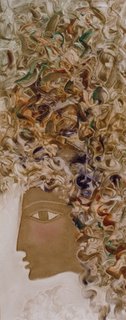
Now, the tree becomes a more dynamic form, it acts as a nurturer where birds find comfort but on the other hand it itself lives in fear of being destroyed. Vigorous brushstrokes blur the existence of the tree. In all his paintings the characters narrate a story whether it is about pretensions - holding up a mask before the whole world, female power or more serious issues about environmental concerns. The emphasis is on the narration and the works themselves are fairly abstract despite being figurative. On the other hand, the drawings on black canvas are a stark contrast to the paintings and are minimal and free from any embellishments.
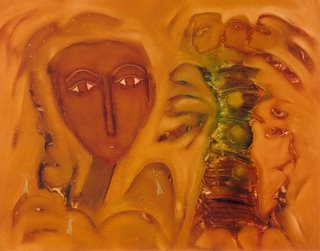
The Vriksha (tree) has been a dynamic element in Vasudev's paintings and has also been a protagonist in some of his works. In this series too, the Vriksha and the mask like face are very much evident. In fact, his early paintings did not have the mask. In the present series, the themes in the paintings remain similar to the earlier works with a few changes. For instance, the protagonist is still a female in the ‘She’ series, but now she takes on a more complicated existence. An elaborate hairdo reveals complex detailing when you look at it closely, suggestive of a whole new world and a gamut of intricacies.

Now, the tree becomes a more dynamic form, it acts as a nurturer where birds find comfort but on the other hand it itself lives in fear of being destroyed. Vigorous brushstrokes blur the existence of the tree. In all his paintings the characters narrate a story whether it is about pretensions - holding up a mask before the whole world, female power or more serious issues about environmental concerns. The emphasis is on the narration and the works themselves are fairly abstract despite being figurative. On the other hand, the drawings on black canvas are a stark contrast to the paintings and are minimal and free from any embellishments.

9 Nov 2006
Interview with artist SG Vasudev
I met Vasudev at a pre-preview of his exhibition of paintings titled ‘Past Forward’ where he revisits his earlier series. The show kick starts in Bangalore and then moves on to other Indian cities. We discussed his art, his passion for promoting art education in Karnataka and also the hype surrounding investments in contemporary Indian Art. Some excerpts...
Q. What made you decide on this series?
A. I have been planning a major retrospective of my works for some time now. About two years ago, I started collecting my paintings from art collectors, galleries and from my private collection. Looking at them, made me feel, it would be interesting to take a fresh look at them. And, to recreate them now. Remember these paintings are also from the 60s and the 70s. In the present series, I find the forms are more defined and the detailing has also increased.
Q. In general, what inspires you to paint?
A. What I did yesterday inspires me today. And, what I do today will inspire me tomorrow. I draw inspiration from different sources – what I read, books, art, happenings around me, they all influence me.
My earlier series have been inspired by poetry, where the Kalpavriksha became central to many of my paintings. Maithuna (Act of Love) was inspired from romantic poetry, Earthscape is about deforestation and the growing ecological imbalance – how people destroy themselves by destroying nature. Theatre of Life came about seeing villagers watching television through the day.
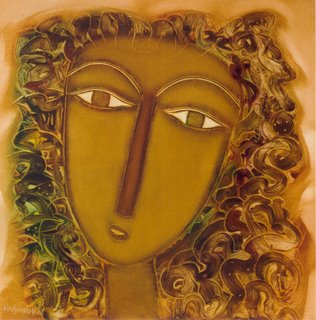
Q. What is the idea behind the mask like faces?
A. I feel all of us wear a mask before the world. To get to know the person, you need to go behind the mask. Whether it’s newsreaders who wear the same expression on every channel or you, we all present a mask to the rest of the world.
Q. You work with only oils…
A. My style of painting is such that oil suits my temperament. I like to finish a painting from start to finish in one go. And, I need to finish it before the paint dries. I work for about 8-12 hours a day when I start on a series.
Q. Do you plan or sketch your paintings beforehand.
A. No, I don’t sketch for a painting. My drawings are meant to be just that – minimal lines that give an idea about the skill and strength of an artist. My paintings evolve as I paint. I start off with an idea, but I don’t plan out the details. I build upon it as I go along. Sometimes accidental effects in one painting become intentional in the next one.
(More on art investment and education later. Watch out this space...)
Q. What made you decide on this series?
A. I have been planning a major retrospective of my works for some time now. About two years ago, I started collecting my paintings from art collectors, galleries and from my private collection. Looking at them, made me feel, it would be interesting to take a fresh look at them. And, to recreate them now. Remember these paintings are also from the 60s and the 70s. In the present series, I find the forms are more defined and the detailing has also increased.
Q. In general, what inspires you to paint?
A. What I did yesterday inspires me today. And, what I do today will inspire me tomorrow. I draw inspiration from different sources – what I read, books, art, happenings around me, they all influence me.
My earlier series have been inspired by poetry, where the Kalpavriksha became central to many of my paintings. Maithuna (Act of Love) was inspired from romantic poetry, Earthscape is about deforestation and the growing ecological imbalance – how people destroy themselves by destroying nature. Theatre of Life came about seeing villagers watching television through the day.

Q. What is the idea behind the mask like faces?
A. I feel all of us wear a mask before the world. To get to know the person, you need to go behind the mask. Whether it’s newsreaders who wear the same expression on every channel or you, we all present a mask to the rest of the world.
Q. You work with only oils…
A. My style of painting is such that oil suits my temperament. I like to finish a painting from start to finish in one go. And, I need to finish it before the paint dries. I work for about 8-12 hours a day when I start on a series.
Q. Do you plan or sketch your paintings beforehand.
A. No, I don’t sketch for a painting. My drawings are meant to be just that – minimal lines that give an idea about the skill and strength of an artist. My paintings evolve as I paint. I start off with an idea, but I don’t plan out the details. I build upon it as I go along. Sometimes accidental effects in one painting become intentional in the next one.
(More on art investment and education later. Watch out this space...)
7 Nov 2006
Banking on Art
I wrote the following article for Financial Times, Bangalore, and it was carried on Nov 4, 2006 in the print version.
With appreciating art prices, art is increasingly seen as an investment option by individuals and Institutions. It now joins other investment avenues such as real estate and mutual funds as a viable and practical alternative. Banks too have started taking an interest in art, in fact Banks have been promoting and sponsoring art events and even artists for some time now.
High Net worth Individuals (HNIs) are actively wooed by Banks in order to manage their investment portfolios. As art becomes all about high finances and sometimes even higher returns, it is not surprising that it is slowly becoming a part of investment portfolios. Surajit Thakur, Senior Vice President and Regional Head of HSBC Bank explains, “There is a lot of latent demand. Artists are doing great work and art has emerged as an alternate class of asset for investment, just like property and mutual funds.”
Growing demand and the ease in trading has ensured that even the uninitiated have started to take an interest in art, even if it is purely for financial reasons. At the same time some financial advisors feel that there is no doubt that the demand is increasing, and more and more people are interested in investing in art; however, it is a niche segment that actually approaches Banks for specialized guidance. Serious art collectors are very likely to have their own databases and an extensive understanding of the trends in the art market; it is usually the first time buyers and upcoming collectors that require expert help.
Surajit Thakur feels with the involvement of Banks, it brings its own set of competencies - an understanding of art, evaluation of its intrinsic value, the commercial angle and at the same time they can show customers the returns and its appreciation trend.
Art collector, Harish Padmanabha believes it is a very good trend since Indian contemporary art market is very active and has gone international as well. He says, “Where earlier art had more of a decorative value, now it is a good investment option, similar to the West, thanks to easy trading. Auctions of repute in various cities like Singapore, New York and London have become common.”
Since it is an asset now, Banks will get involved. Just as financial advisors provide guidance on the stock market and mutual funds and manage portfolios on behalf of their clients, the art market is similar. An understanding of art and the market trends will be of great help to the uninitiated. Padmanabha asserts that since Banks have their reputation to protect and their money, they will therefore make sure that they provide experts to guide their clients.
Art too is not free of investment risks, unless one plays safe and buys the top end of the artists. But, most of the times these will be out of range for a good number of people. He advises, “The mid-level artists may not be doing too well in international auctions but generally their market within the country is quite safe.” When it comes to upcoming artists, one can never predict with certainty. However, it is better to have expert help since it is a specialized field. A combination of art expertise and financial know-how seems like a healthy blend, and more and more people are likely to take advantage of this trend.
With appreciating art prices, art is increasingly seen as an investment option by individuals and Institutions. It now joins other investment avenues such as real estate and mutual funds as a viable and practical alternative. Banks too have started taking an interest in art, in fact Banks have been promoting and sponsoring art events and even artists for some time now.
High Net worth Individuals (HNIs) are actively wooed by Banks in order to manage their investment portfolios. As art becomes all about high finances and sometimes even higher returns, it is not surprising that it is slowly becoming a part of investment portfolios. Surajit Thakur, Senior Vice President and Regional Head of HSBC Bank explains, “There is a lot of latent demand. Artists are doing great work and art has emerged as an alternate class of asset for investment, just like property and mutual funds.”
Growing demand and the ease in trading has ensured that even the uninitiated have started to take an interest in art, even if it is purely for financial reasons. At the same time some financial advisors feel that there is no doubt that the demand is increasing, and more and more people are interested in investing in art; however, it is a niche segment that actually approaches Banks for specialized guidance. Serious art collectors are very likely to have their own databases and an extensive understanding of the trends in the art market; it is usually the first time buyers and upcoming collectors that require expert help.
Surajit Thakur feels with the involvement of Banks, it brings its own set of competencies - an understanding of art, evaluation of its intrinsic value, the commercial angle and at the same time they can show customers the returns and its appreciation trend.
Art collector, Harish Padmanabha believes it is a very good trend since Indian contemporary art market is very active and has gone international as well. He says, “Where earlier art had more of a decorative value, now it is a good investment option, similar to the West, thanks to easy trading. Auctions of repute in various cities like Singapore, New York and London have become common.”
Since it is an asset now, Banks will get involved. Just as financial advisors provide guidance on the stock market and mutual funds and manage portfolios on behalf of their clients, the art market is similar. An understanding of art and the market trends will be of great help to the uninitiated. Padmanabha asserts that since Banks have their reputation to protect and their money, they will therefore make sure that they provide experts to guide their clients.
Art too is not free of investment risks, unless one plays safe and buys the top end of the artists. But, most of the times these will be out of range for a good number of people. He advises, “The mid-level artists may not be doing too well in international auctions but generally their market within the country is quite safe.” When it comes to upcoming artists, one can never predict with certainty. However, it is better to have expert help since it is a specialized field. A combination of art expertise and financial know-how seems like a healthy blend, and more and more people are likely to take advantage of this trend.
6 Nov 2006
Art Buzz
(All updates are currently for Bangalore)
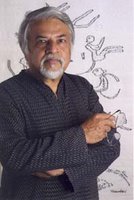 In 'Past Forward' one can see artist SG Vasudev revisiting his earlier series such as Maithuna, Tree of Life, He and She, Humanscape, Earthscape and Theatre of Life - the work created over the past four decades. On view from Nov 10 - 23, 2006 at Gallery Sumukha. The exhibition then moves on to Mumbai, Vadodara, Kolkata, Hyderabad, Chennai and Cochin.
In 'Past Forward' one can see artist SG Vasudev revisiting his earlier series such as Maithuna, Tree of Life, He and She, Humanscape, Earthscape and Theatre of Life - the work created over the past four decades. On view from Nov 10 - 23, 2006 at Gallery Sumukha. The exhibition then moves on to Mumbai, Vadodara, Kolkata, Hyderabad, Chennai and Cochin.
 In 'Past Forward' one can see artist SG Vasudev revisiting his earlier series such as Maithuna, Tree of Life, He and She, Humanscape, Earthscape and Theatre of Life - the work created over the past four decades. On view from Nov 10 - 23, 2006 at Gallery Sumukha. The exhibition then moves on to Mumbai, Vadodara, Kolkata, Hyderabad, Chennai and Cochin.
In 'Past Forward' one can see artist SG Vasudev revisiting his earlier series such as Maithuna, Tree of Life, He and She, Humanscape, Earthscape and Theatre of Life - the work created over the past four decades. On view from Nov 10 - 23, 2006 at Gallery Sumukha. The exhibition then moves on to Mumbai, Vadodara, Kolkata, Hyderabad, Chennai and Cochin.
Shankar Kendale's figuratives works will be on view at KYNKYNY till Nov 30, 2006.
Anand Bekwad, a young and upcoming artist presents his mixed media works from Nov 11-20, 2006 at Akshana Art Gallery.
Raosaheb Gurav, an artist from Pune exhibits his paintings on rural themes in Gallery G. On view till Nov 7, 2006.
Raosaheb Gurav, an artist from Pune exhibits his paintings on rural themes in Gallery G. On view till Nov 7, 2006.
2 Nov 2006
Artist Atul Dodiya narrates Sabari's tale
I met Atul Dodiya when he was in Bangalore for the opening of his exhibition. I wrote the following article for the Sunday Times of India, Bangalore. Since, Dodiya is doing well internationally I thought of sharing the write-up.
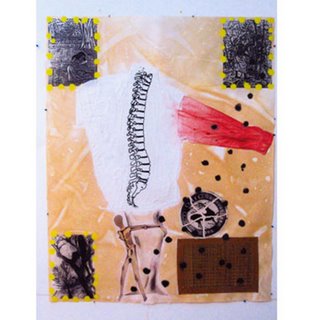 Titled ‘The wet sleeves of my paper robe (Sabari in her youth: after Nandalal Bose)’, the mixed media works with paper pulp, and print are the outcome of a workshop held in Singapore recently. Inspired by a series that artist Nandalal Bose did on Sabari in the year 1941, Dodiya re-narrates Sabari’s tale. Guided by American artist and paper-maker Richard Hungerford and Japanese master print-maker Eitaro Ogawa, Dodiya came up with the present series. Drawn from the epic Ramayana, the protagonist is Sabari the tribal woman who offered berries to Lord Rama after tasting them. His Sabari is presented in the contemporary context where scatted bones and red-stained shirts describe the epic war as much as they comment on the violence in recent times.
Titled ‘The wet sleeves of my paper robe (Sabari in her youth: after Nandalal Bose)’, the mixed media works with paper pulp, and print are the outcome of a workshop held in Singapore recently. Inspired by a series that artist Nandalal Bose did on Sabari in the year 1941, Dodiya re-narrates Sabari’s tale. Guided by American artist and paper-maker Richard Hungerford and Japanese master print-maker Eitaro Ogawa, Dodiya came up with the present series. Drawn from the epic Ramayana, the protagonist is Sabari the tribal woman who offered berries to Lord Rama after tasting them. His Sabari is presented in the contemporary context where scatted bones and red-stained shirts describe the epic war as much as they comment on the violence in recent times.
White cotton shirts, synthetic hair and paper-cast flowers are embedded in pulp while some flowers are also covered by gold leaf. Cultural theorist and curator Ranjit Hoskote writes, “ Sabari is given her freedom in this imaginative re-rendering. The archetype of a life premised on anticipation, a figure lost at the edges of the triumphal march of the Lord, she becomes the epicenter of Dodiya’s seismic recasting of the epic. In Dodiya’s account, she talks to the red birds of the forest that is both in her mind and around her; she grows more heads than the one filled with beatific visions of the Divine. She shakes a rain of fruits from a tree as austere as Mondrian; she dances across a river of bones, visits the battlefields of the future where skeletons have formed into large subterranean assemblies.”
Dodiya began his artistic career painting in a photo-realistic manner, however with time his paintings became more contemporary in nature. He feels an artist’s work should provoke and not aim to please. He enjoys working with different cultural contexts and presenting local subjects in a global style.
He firmly believes that every artist has a social responsibility. One cannot paint in an ivory tower. While twenty years ago there was more freedom and viewers were more positive and acceptance was greater. While now, often political parties and ideology plays a role.
How easy it is for a common man to understand art? “Even artists cannot understand modern art at times, let alone the common man. However, those related to art for instance, regular visitors to art exhibitions will find it easier,” explains Dodiya. “But everyone irrespective of their art initiation will have a response – a strong like or dislike!”
 Titled ‘The wet sleeves of my paper robe (Sabari in her youth: after Nandalal Bose)’, the mixed media works with paper pulp, and print are the outcome of a workshop held in Singapore recently. Inspired by a series that artist Nandalal Bose did on Sabari in the year 1941, Dodiya re-narrates Sabari’s tale. Guided by American artist and paper-maker Richard Hungerford and Japanese master print-maker Eitaro Ogawa, Dodiya came up with the present series. Drawn from the epic Ramayana, the protagonist is Sabari the tribal woman who offered berries to Lord Rama after tasting them. His Sabari is presented in the contemporary context where scatted bones and red-stained shirts describe the epic war as much as they comment on the violence in recent times.
Titled ‘The wet sleeves of my paper robe (Sabari in her youth: after Nandalal Bose)’, the mixed media works with paper pulp, and print are the outcome of a workshop held in Singapore recently. Inspired by a series that artist Nandalal Bose did on Sabari in the year 1941, Dodiya re-narrates Sabari’s tale. Guided by American artist and paper-maker Richard Hungerford and Japanese master print-maker Eitaro Ogawa, Dodiya came up with the present series. Drawn from the epic Ramayana, the protagonist is Sabari the tribal woman who offered berries to Lord Rama after tasting them. His Sabari is presented in the contemporary context where scatted bones and red-stained shirts describe the epic war as much as they comment on the violence in recent times.White cotton shirts, synthetic hair and paper-cast flowers are embedded in pulp while some flowers are also covered by gold leaf. Cultural theorist and curator Ranjit Hoskote writes, “ Sabari is given her freedom in this imaginative re-rendering. The archetype of a life premised on anticipation, a figure lost at the edges of the triumphal march of the Lord, she becomes the epicenter of Dodiya’s seismic recasting of the epic. In Dodiya’s account, she talks to the red birds of the forest that is both in her mind and around her; she grows more heads than the one filled with beatific visions of the Divine. She shakes a rain of fruits from a tree as austere as Mondrian; she dances across a river of bones, visits the battlefields of the future where skeletons have formed into large subterranean assemblies.”
Dodiya began his artistic career painting in a photo-realistic manner, however with time his paintings became more contemporary in nature. He feels an artist’s work should provoke and not aim to please. He enjoys working with different cultural contexts and presenting local subjects in a global style.
He firmly believes that every artist has a social responsibility. One cannot paint in an ivory tower. While twenty years ago there was more freedom and viewers were more positive and acceptance was greater. While now, often political parties and ideology plays a role.
How easy it is for a common man to understand art? “Even artists cannot understand modern art at times, let alone the common man. However, those related to art for instance, regular visitors to art exhibitions will find it easier,” explains Dodiya. “But everyone irrespective of their art initiation will have a response – a strong like or dislike!”
Subscribe to:
Posts (Atom)
